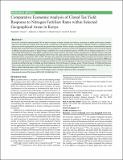Comparative Economic Analysis of Clonal Tea Yield Response to Nitrogen Fertiliser Rates within Selected Geographical Areas in Kenya

View/
Publication Date
2020Author
Rosebell A. Owuor1; *, Alphonce J. Odondo , P. Okinda Owuor , David M. Kamau
Metadata
Show full item recordAbstract/
Tea sector contributes approximately 30% of export earnings in Kenya. Despite the industry continuing to realize positive gross margins,
high costs of production coupled with weak trends in export prices threaten its future contributions. Nitrogen fertiliser is mandatory in tea
production and its appropriate use promotes tea growth rate and yields. Previous studies using different tea cultivars established that optimal
fertiliser rates varied with clones and geographical area of production. However, economics of nitrogenous fertilisers use on same tea cultivar
in different tea growing regions in Kenya remains undefined. This study evaluated response of NPKS 25:5:5:5 fertiliser applied at 0, 75, 150,
225 and 300 kg N/ha/year on clone BBK35 to determine the viable economic rate under uniform management in different locations (Karirana,
Timbilil, Changoi, Sotik Highlands and Kipkebe) within Kenya. The study used time series tea yield data and corresponding variable costs from
field experiments running from 1997 to 2007. The data were subjected to Partial Budget Analysis (PBA) procedures for economic analysis of
on-farm experiments. The economic returns varied with rate of nitrogen and region of production. Maximum marginal rate of return (MRR) were
achieved at 75 kg N/ha/year at Kipkebe, Changoi and Timbilil, and 150 at Sotik Highlands and Karirana. However best economic returns were
recorded at 300 kg N/ha/year in Kipkebe and Sotik Highlands, 225 kg N/ha/year in Changoi, and at 150 kg N/ha/year in Timbilil and Karirana.
These results demonstrate that current uniform fertiliser recommendation rate of 100 to 220 kg N/ha/year may not be suitable for all regions.
There is need to develop region specific nitrogen fertiliser requirements for tea growing areas in Kenya.
Collections
- Department of Chemistry [339]
